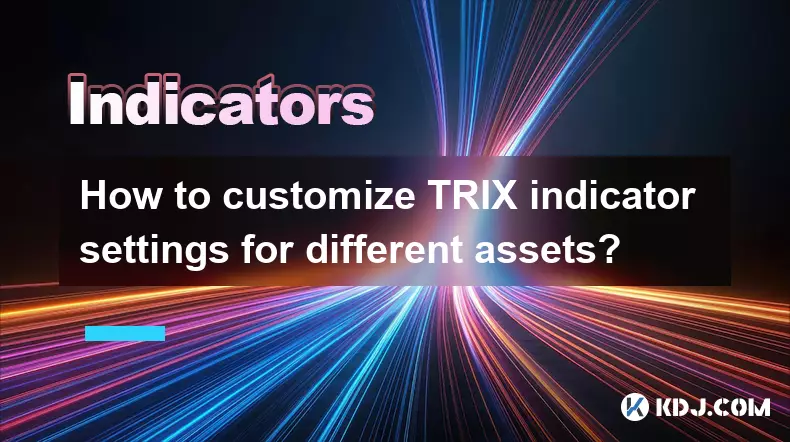-
 bitcoin
bitcoin $102877.190955 USD
1.88% -
 ethereum
ethereum $3430.435064 USD
4.52% -
 tether
tether $0.999264 USD
-0.05% -
 xrp
xrp $2.307310 USD
4.49% -
 bnb
bnb $987.740692 USD
3.82% -
 solana
solana $161.947760 USD
3.97% -
 usd-coin
usd-coin $0.999712 USD
-0.05% -
 tron
tron $0.292810 USD
2.93% -
 dogecoin
dogecoin $0.179738 USD
10.70% -
 cardano
cardano $0.580716 USD
8.75% -
 hyperliquid
hyperliquid $42.463448 USD
8.40% -
 chainlink
chainlink $15.763437 USD
7.05% -
 zcash
zcash $649.595636 USD
17.21% -
 bitcoin-cash
bitcoin-cash $511.610261 USD
7.19% -
 stellar
stellar $0.292537 USD
7.91%
How to build a complete trading system around the TRIX indicator?
The TRIX indicator’s triple-smoothed EMA filters noise, offering early momentum shifts and reliable trend signals when combined with volume, volatility, and price action confirmation.
Nov 06, 2025 at 02:00 pm

Understanding the TRIX Indicator and Its Core Mechanics
1. The TRIX (Triple Exponential Average) indicator is derived from a triple-smoothed exponential moving average, designed to filter out insignificant price movements and highlight meaningful trends. By applying three layers of EMA calculations, it reduces market noise significantly compared to standard momentum oscillators.
2. A signal line, typically a 9-period EMA of the TRIX values, is used to generate trade signals through crossovers. When the TRIX line crosses above the signal line, it suggests bullish momentum; when it crosses below, bearish momentum may be emerging.
3. Zero-line crossovers offer additional context—values above zero indicate positive momentum, while readings below suggest negative momentum. This dual-signal approach enhances reliability in identifying trend direction and strength.
4. Unlike RSI or MACD, TRIX reacts slower due to its triple smoothing, making it more suitable for swing traders and investors focused on medium- to long-term trends rather than scalping.
5. The core advantage lies in its ability to detect subtle shifts in momentum before price action fully reflects them, giving early entry opportunities in trending markets.
Integrating TRIX into a Multi-Layered Entry Strategy
1. Combine TRIX with volume-weighted moving averages to confirm breakout validity. For instance, if TRIX generates a buy signal during a period of rising volume and price above the 50-day VWAP, the probability of sustained upward movement increases.
2. Use Bollinger Bands to assess volatility compression before acting on TRIX signals. Breakouts following tight bands combined with a TRIX crossover often lead to strong directional moves, especially in altcoins experiencing accumulation phases.
3. Add support/resistance confluence by aligning TRIX-generated entries with key horizontal levels or Fibonacci retracements. A bullish crossover near a well-established support zone adds weight to the setup.
4. Incorporate candlestick patterns such as bullish engulfing or hammer formations at moments of TRIX reversal for higher-confidence entries. These patterns act as micro-timing triggers within the broader momentum shift.
5. Avoid blind reliance on crossovers during sideways markets—filter signals using ADX to ensure that the market exhibits sufficient trend strength before executing trades.
Risk Management and Exit Framework Using TRIX
1. Set dynamic trailing stops based on recent swing lows (for longs) or highs (for shorts), adjusted only when new TRIX-based momentum confirms continuation. This protects profits without premature exits due to minor pullbacks.
2. Define position size according to the distance between entry and stop-loss level, ensuring no single trade risks more than 2% of total capital. High-volatility cryptocurrencies require smaller allocations even when TRIX signals appear strong.
3. Use reverse TRIX crossovers as initial exit warnings. While not an automatic close signal, a bearish crossover after a prolonged uptrend should prompt reassessment of holding rationale and potential profit-taking.
p>4. Monitor divergence between price and TRIX for early reversal signs. If price makes a higher high but TRIX forms a lower high, it indicates weakening momentum and justifies tightening stops or scaling out of positions.
5. Incorporate time-based exits for stagnant positions—holdings that show no meaningful progress within five trading sessions after entry may indicate false signals and warrant reevaluation.
Frequently Asked Questions
What timeframes work best with the TRIX indicator in crypto trading?TRIX performs optimally on hourly and daily charts, where noise is minimized and trend signals carry greater significance. On lower timeframes like 5-minute or 15-minute, whipsaws increase substantially, reducing signal accuracy.
Can TRIX be used effectively in ranging cryptocurrency markets?Its effectiveness diminishes in choppy or range-bound conditions due to lag from triple smoothing. Traders should disable TRIX-based entries when volatility indicators like ATR fall below historical averages or when price oscillates within a narrow band for extended periods.
How does TRIX compare to MACD in detecting early trend changes?While both are momentum-based, TRIX tends to produce fewer false signals because of deeper smoothing. However, this also means delayed reactions compared to MACD. In fast-moving crypto environments, TRIX excels in confirming established trends rather than capturing the very first move.
Is it advisable to automate a TRIX-based strategy on exchange APIs?Automation is feasible but requires additional filters such as minimum volume thresholds, trend confirmation via ADX, and exclusion periods around major news events. Blind algorithmic execution based solely on TRIX crossovers often leads to drawdowns during consolidation phases.
Disclaimer:info@kdj.com
The information provided is not trading advice. kdj.com does not assume any responsibility for any investments made based on the information provided in this article. Cryptocurrencies are highly volatile and it is highly recommended that you invest with caution after thorough research!
If you believe that the content used on this website infringes your copyright, please contact us immediately (info@kdj.com) and we will delete it promptly.
- BlockDAG, Avalanche, Dogecoin: Crypto's Leading Trio in 2025
- 2025-11-07 22:05:01
- Layer 2 Coins: Will There Be a Potential Explosion by 2026?
- 2025-11-07 16:50:02
- Filecoin, ICP, and the AI Infrastructure Renaissance: Is History Repeating?
- 2025-11-07 16:50:02
- Bitcoin's Wild Ride: Surges, Zeros, and the Search for Stability
- 2025-11-07 17:05:01
- XRP, Bitcoin, and the Rally: What's the Deal, New York?
- 2025-11-07 17:25:01
- Filecoin, DePIN, and a Technical Breakout: What's the Buzz?
- 2025-11-07 17:05:01
Related knowledge

How do professional traders use the TRIX indicator?
Nov 06,2025 at 04:40pm
Understanding the TRIX Indicator in Crypto TradingThe TRIX (Triple Exponential Average) indicator is a momentum oscillator used by professional trader...

Can I use the TRIX indicator on my mobile trading app?
Nov 07,2025 at 07:40pm
The TRIX indicator, a momentum oscillator designed to filter out short-term fluctuations and highlight long-term trends, has become increasingly popul...

How to code a simple TRIX indicator script in Pine Script?
Nov 07,2025 at 06:20am
How to Code a Simple TRIX Indicator in Pine Script The TRIX (Triple Exponential Moving Average) indicator is widely used in cryptocurrency trading to ...

How to trade TRIX indicator signals on the 1-hour chart?
Nov 07,2025 at 05:39am
Bitcoin's Role in Decentralized Finance1. Bitcoin remains the cornerstone of decentralized finance, serving as a benchmark for value and security acro...

Can the TRIX indicator be used for long-term investing?
Nov 06,2025 at 02:19pm
Understanding the TRIX Indicator in Cryptocurrency Markets1. The TRIX (Triple Exponential Average) indicator is a momentum oscillator designed to filt...

How to customize TRIX indicator settings for different assets?
Nov 06,2025 at 03:39pm
Understanding the TRIX Indicator in Cryptocurrency Trading1. The TRIX (Triple Exponential Average) indicator is a momentum oscillator designed to filt...

How do professional traders use the TRIX indicator?
Nov 06,2025 at 04:40pm
Understanding the TRIX Indicator in Crypto TradingThe TRIX (Triple Exponential Average) indicator is a momentum oscillator used by professional trader...

Can I use the TRIX indicator on my mobile trading app?
Nov 07,2025 at 07:40pm
The TRIX indicator, a momentum oscillator designed to filter out short-term fluctuations and highlight long-term trends, has become increasingly popul...

How to code a simple TRIX indicator script in Pine Script?
Nov 07,2025 at 06:20am
How to Code a Simple TRIX Indicator in Pine Script The TRIX (Triple Exponential Moving Average) indicator is widely used in cryptocurrency trading to ...

How to trade TRIX indicator signals on the 1-hour chart?
Nov 07,2025 at 05:39am
Bitcoin's Role in Decentralized Finance1. Bitcoin remains the cornerstone of decentralized finance, serving as a benchmark for value and security acro...

Can the TRIX indicator be used for long-term investing?
Nov 06,2025 at 02:19pm
Understanding the TRIX Indicator in Cryptocurrency Markets1. The TRIX (Triple Exponential Average) indicator is a momentum oscillator designed to filt...

How to customize TRIX indicator settings for different assets?
Nov 06,2025 at 03:39pm
Understanding the TRIX Indicator in Cryptocurrency Trading1. The TRIX (Triple Exponential Average) indicator is a momentum oscillator designed to filt...
See all articles





















![The Graph Price Prediction [GRT Crypto Price News Today] The Graph Price Prediction [GRT Crypto Price News Today]](/uploads/2025/11/07/cryptocurrencies-news/videos/690d4df44fe69_image_500_375.webp)



















































